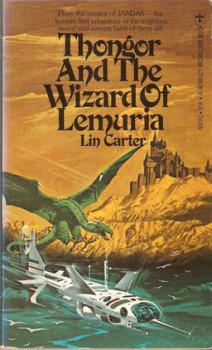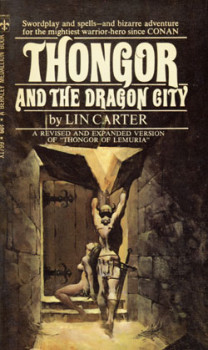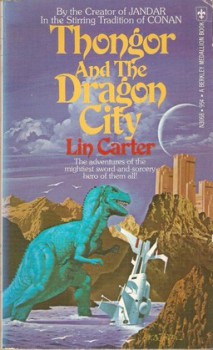Thongor of Lemuria – Part One by Lin Carter
 If I didn’t know better, I’d swear Lin Carter’s Thongor of Lemuria novels were a deliberate exercise in camp. The first two novels in the seven book series, Thongor And The Wizard of Lemuria (1965) and Thongor And The Dragon City (1966), are so frenetic and exaggerated there are times it’s difficult to believe they were intended to be taken seriously. I struggle to believe that Carter hadn’t meant for me to laugh when I read that Thongor distrusted magic because of his “clean healthy, Northlander blood.”
If I didn’t know better, I’d swear Lin Carter’s Thongor of Lemuria novels were a deliberate exercise in camp. The first two novels in the seven book series, Thongor And The Wizard of Lemuria (1965) and Thongor And The Dragon City (1966), are so frenetic and exaggerated there are times it’s difficult to believe they were intended to be taken seriously. I struggle to believe that Carter hadn’t meant for me to laugh when I read that Thongor distrusted magic because of his “clean healthy, Northlander blood.”
But I do know better. Much has been written (some of it by me) about Lin Carter’s love for heroic fantasy and his efforts to emulate his favorite writers in his own books. The Thongor stories read like he took Robert E. Howard’s Conan stories, smooshed them together with Edgar Rice Burroughs’ John Carter novels, then cranked everything up to eleven. But, and this is true of his Lovecraft Mythos fiction too, he mimics the style of his literary heroes without ever conveying the substance that gives power to their work to this day.
To give Lin Carter his due, Wizard of Lemuria is his first published novel and Dragon City his third in only two years. In those ancient times, there was little new swords & sorcery of the mighty barbarian type being written. Michael Moorcock and Fritz Leiber were tweaking (and tweaking the nose of) the genre and Karl Edward Wagner and Charles Saunders were still kids. The big boom was right around the corner, but it hadn’t happened yet. He took the chance and stepped up to create the sort of stories he wanted to see and that’s something I will always respect.
One of the earliest reviews at my site, Swords & Sorcery: A Blog, was of Thongor And The Wizard of Lemuria (so, yes, for those of you who’ve read it, I have indeed read it a second time). It was harsh and a little intemperate. I’ve since decided that reviews of that sort don’t serve any real purpose. I also don’t want to pick on someone who can’t fight back. I want my reviews to promote the good books and understand why the weak ones fail and encourage better writing.
Like August Derleth and Sprague de Camp, Lin Carter’s too readily bad-mouthed these days (except when the stupendously important Ballantine Adult Fantasy Series is mentioned). I don’t think his fiction is read that much anymore and I feel I owe him at least the courtesy of that. So I’m going to plow through the series and report back to you, Black Gate‘s faithful readers.
 Thongor And The Wizard of Lemuria and Thongor And The Dragon City really form a single story in which Thongor has adventures, meets a girl, saves the world, has some more adventures, then becomes a king. Thongor is a black-maned barbarian (sometimes with a capital B), from the the snowy wastes of northern Lemuria, and it’s about the year 492,993 B.C. Following numerous previous adventures alluded to throughout the book (and collected in the highly recommendable Young Thongor which I reviewed here), he begins here a soldier in the service of the Sark (that’s Lemurian for king) of Thurdis.
Thongor And The Wizard of Lemuria and Thongor And The Dragon City really form a single story in which Thongor has adventures, meets a girl, saves the world, has some more adventures, then becomes a king. Thongor is a black-maned barbarian (sometimes with a capital B), from the the snowy wastes of northern Lemuria, and it’s about the year 492,993 B.C. Following numerous previous adventures alluded to throughout the book (and collected in the highly recommendable Young Thongor which I reviewed here), he begins here a soldier in the service of the Sark (that’s Lemurian for king) of Thurdis.
Wizard opens as a fight breaks out between Thongor and his captain over a gambling debt. Of course, dueling a nobleman rarely goes well for a barbarian in these sorts of stories and it doesn’t here. Thongor ends up in the Sark’s dungeon awaiting certain death from the narcotic petals of the vampire flowers. Thanks to “the fatalistic philosophy of the North that wastes no time worrying over what cannot be helped,” he simply shrugs his shoulders at his fate. The fortuitous (and there’s lots of fortuitousness in these books) intervention of an old comrade-in-arms allows the young barbarian to escape his doom.
Carter’s great at tossing the reader into the middle of things. Despite lots of garbled syntax, there’s a marvelous momentum to these books that makes them quick reads, sometimes leaving me almost breathless. Lots of stuff happens in both books and neither is more than 141 pages long.
But that’s also Carter’s greatest failing: he rarely slows down enough to create any sort of atmosphere. The characters are one-dimensional, the descriptions are unimaginative, the plot twists are generic. He’s too caught up in racing from the jungle to the lost ruins to the dungeons and back to the jungle to ever pause and let things breathe.
Immediately upon escaping the dungeon, Thongor steals the Sark’s brand new and revolutionary flying boat. He manages to crash it into the vast trackless jungles of Chush after he falls asleep at the wheel. He is rescued by the reclusive Sharajsha, commonly referred to as the Wizard of Lemuria. It seems he’s been looking for a man just like Thongor to help him save the world from the Dragon Kings.
See, the Dragon Kings used to rule the world until they were overthrown by the big-brained primates they held in contempt. Now, when the stars move to the right position, they hope to summon their evil demon god (partially, it turns out, with the power of dance) and return to dominion over the Earth.
 During the course of his adventures in Wizard, Thongor gains a sidekick and rescues a princess. The princess, Sumia, falls for the big Northerner and he for her. This is important for events in Thongor And The Dragon City. In Sumia’s hometown of Patanga, power in the city has been usurped from its rightful wielders by the evil, and often fat, Yellow Druids of Yamath, Lord of the Flames.
During the course of his adventures in Wizard, Thongor gains a sidekick and rescues a princess. The princess, Sumia, falls for the big Northerner and he for her. This is important for events in Thongor And The Dragon City. In Sumia’s hometown of Patanga, power in the city has been usurped from its rightful wielders by the evil, and often fat, Yellow Druids of Yamath, Lord of the Flames.
The overarching plot in Dragon City is the effort of Thongor’s old employer, the Sark of Thurdis, to conquer all of civilized Lemuria. Over the course of the book, Thongor and his companions face off against cavemen, giant monstrous worms, and super-science. Of the two books, it’s the better. The main villains are developed a bit more and almost gain a second dimension.
Carter’s most successful creation in either book is the secondary villain, Thalaba the Destroyer. Instead of the mighty thewed warrior his name seems to indicate, he’s something else entirely:
The gate creaked open stealthily. A robed and hooded figure peered out. Every inch of it was muffled, from head to toe, in rough black cloth. It was bent and shriveled, and stood half the height of a man.
“Yes…” came a whisper, mocking, shrill, with delicate overtones of humor.
“This man has a secret desired by the High-Born. The Sark wishes to know the whereabouts of his airboat, stolen by this man. I am bidden to deliver him to Thalaba the Destroyer,” said the old commander.
A faint, eery whisper of chill laughter from the tiny, hunched figure whose face was hidden in black robes.
“But I am Thalaba….”
With the Destroyer’s introduction, my hopes for Dragon City were buoyed for a few moments (even if I’m not sure how a gate creaks stealthily). Sadly, Thalaba, as did so many of the book’s elements, proved a disappointment. He scurries on stage for a few pages and creates a real moment of creepiness, only to vanish into the darkness of the dungeons. He reappears in the climactic battle only to suffer an anti-climactic fate.
 Putting aside the bad prose, it’s Carter’s need to jam too much into slim books that proves his undoing. When the adventure and characters are fun my tolerance for bad writing is pretty high, but it’s like he never threw away a single idea that crossed his mind. I can picture him at his desk saying, “This story needs a vampiric overlord in a ruined city AND a giant gelatinous worm AND a magnetic ray AND cavemen. OH YEAH, and Thongor needs to swing through the trees because that’s just cool.”
Putting aside the bad prose, it’s Carter’s need to jam too much into slim books that proves his undoing. When the adventure and characters are fun my tolerance for bad writing is pretty high, but it’s like he never threw away a single idea that crossed his mind. I can picture him at his desk saying, “This story needs a vampiric overlord in a ruined city AND a giant gelatinous worm AND a magnetic ray AND cavemen. OH YEAH, and Thongor needs to swing through the trees because that’s just cool.”
I hope this review of Thongor and the Wizard of Lemuria makes up for my earlier, snarky one. I’ve come to appreciate some of Carter’s writing. Kellory the Warlock is a decent enough book (reviewed here). I like the Young Thongor stories enough that I’m almost willing to call them lost classics of S&S. I’m well into his Hollow Earth book, Zanthodon, and it’s really good. But I struggle to find substantive good things to say about the first two Thongor novels.
In the next few months, I’ll be back with reviews of the rest of the original books in the series: Thongor Against the Gods, Thongor in the City of Magicians, Thongor at the End of Time, and Thongor Fights the Pirates of Tarakus. I owe it to him to read the books before dismissing them, and he did get better at writing over time. So here’s hoping!
I can only recommend them to readers who want to get a fuller understanding of the evolution of the genre. Happily, Lin Carter’s reputation doesn’t rest solely on his writing. To this day, I don’t think there’s been an editor or fan who has done as much to promote and foster swords & sorcery. (You should search Black Gate for Keith West’s great ongoing reviews of the Ballantine Adult Fantasy Series — or just click here.)
Note for the brave: Like most of Lin Carter’s catalog, the Thongor books have been out of print for decades. Through the magic of Amazon cheap paperbacks are readily available.
Well said!
I always enjoy Carter as a comfort read. There’s a crazy cross-pollinating fertility to his imagination that makes up for the less than perfect prose, or the clunky authorial intrusions.
I can’t bring myself to hate his writing. I suspect the whole “crazy cross-pollinating” thing has a lot to do with it. There’s so much potential for fun in his ideas that even when he he fails (much of the time) to pull it together it’s at least worth a couple of hours of my time.
I’m going to be reviewing his HPL-fiction in The Xothic Cycle at my site in a few weeks so we’ll see how much tolerance I’ve really developed for him. Even his friend Robert M. Price in the forward implies there misfires.
I’ve read a handful of Carter’s books, including a couple of the Thongor novels. And I always close the book with the feeling of “That was a good first draft.” I think with some revisions, to include a lot of expansion i the narrative, and a healthy dose of editorial kung fu, his books could have been much more epic.
The thing is, he wrote so damn much! Donald Wollheim wasn’t running a charity – someone was actually buying these books. (I confess, without pride – but also without shame – that I was one of them.)
@TDoolan – Exactly! I think he worked too fast and too much. There’s great pulpy insanity in these books and they needed an editor’s guiding hand to polish them.
@Thomas Parker – I agree. My dad bought lots of Carter over the years. I don’t have it in front of me, but int he forward to Wizard of Lemuria, Carter lists several impressive fans of Thongor. The only one I remember is Lloyd Alexander, which is pretty cool.
If Carter was writing this stuff for the pulps of the 30’s and 40’s, people might have a different opinion about the “quality” of his writing. Remember, paperbacks from the 1960’s onward into the 1980’s were the direct replacements of those old-school pulp magazines of yesterday, in just a slightly more “literary” format! Thongor is ok, but I really like his Zanthodon stories-pure Edgar Rice Burroughs Pellucidar rip-off, but a real hoot just the same.
@thedarkman – several people have made the same observation about “if Lin Carter had written for the pulps” and I agree. But, alas, he didn’t. Not soon after his heyday the demand for better writing than most of his increased. I hesitate to call him a third rate writer as some have, if only because I think he was capable of some good work when he took the time.
Now I’m halfway thru the first Zanthodon book, Journey To the Underground World, and it’s good, silly fun.
I thought his character of Thongor was just boring, he had really no flaws and was too perfect. I did like his Green Star and Silvermane series.
Thanks for the shout-out, Fletcher.
And thanks for your reviews about Carter. I’ve not read him yet, but I’m going to have to, in order to have an informed opinion on his work if for no other reason. You’ve given me some ideas of where to start.
@westkeith how is that even possible!?! 😉
Pick a series! Any series! Callisto is planetary romance. Green Star is slightly more exotic planetary romance. Thongor is, well, Thongor. World’s End is Dying Earth-style far future. Zanthodon is Pellucidar.
I haven’t read all of them myself — never actually touched Callisto or Zanthodon, for some reason. One thing I do appreciate is that most books have author’s notes or introductions where he talks very frankly about his influences and what he was trying to accomplish — for example, was it the Green Star books where he said he was trying to do Burroughs but with the style of A.E. Merritt?
A bit of a late comment, but Thongor fans may wish to look up two chapbooks of – I would guess fan fiction – by Robert M. Price, both publised by Rainfall Publications in the UK. I found them enjoyable.
Witch-queen of Lemuria – http://www.rainfallsite.com/Chapbooks01.html and
Mind Lords of Lemuria – http://www.rainfallsite.com/Chapbooks04.html
You will have to scroll a bit, best I culd do was post the catalogue list pages.
@Tiberius – Thanks for the info! Mind Lords is in YOUNG THONGOR but Witch-Queen isn’t.
[…] reviewed at Black Gate that I’m sadder to be unable to recommend. I had no qualms about warning readers off Lin Carter’s first two Thongor books. But Carter wasn’t a skilled, original writer […]
[…] Leiber’s Fafhrd and the Grey Mouser and assorted other sword-wielding adventurers – Kothar, Thongor, et cetera. J.R.R. Tolkien’s the Lord of the Rings came out in paperback circa 1965, and […]